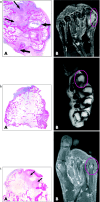High-grade MRI bone oedema is common within the surgical field in rheumatoid arthritis patients undergoing joint replacement and is associated with osteitis in subchondral bone
- PMID: 17491098
- PMCID: PMC2095325
- DOI: 10.1136/ard.2007.070326
High-grade MRI bone oedema is common within the surgical field in rheumatoid arthritis patients undergoing joint replacement and is associated with osteitis in subchondral bone
Abstract
Objectives: MRI bone oedema has been observed in early and advanced RA and may represent a cellular infiltrate (osteitis) in subchondral bone. We studied MRI scans from RA patients undergoing surgery, seeking to identify regions of bone oedema and examine its histopathological equivalent in resected bone.
Methods: Preoperative contrast-enhanced MRI scans were obtained in 11 RA patients scheduled for orthopaedic surgery to the hands/wrists or feet. In 9, MRI scans were scored by 2 readers for bone oedema (RAMRIS system). Its distribution with respect to surgical site was investigated. In 4 patients, 7 bone samples were examined for a cellular infiltrate, and this was compared with MRI bone oedema, scored for spatial extent and intensity.
Results: Inter-reader intraclass correlation coefficients for bone oedema were 0.51 (all sites) and 0.98 (bone samples for histology). Bone oedema was observed at 60% of surgical sites vs 38% of non-surgical sites. High-grade bone oedema (score >/=50% maximum) was strongly associated with the surgical field (OR 9.3 (3.5 to 24.2), p<0.0001). Bone oedema scores correlated with pain (r = 0.67, p = 0.048) and CRP (r = 0.86, p = 0.01). In 4 of the 7 bone samples, there was concordance between bone oedema and subchondral osteitis. In 3, there was no MRI bone oedema, and osteitis was "slight".
Conclusion: High-grade MRI bone oedema was common within the field of intended surgery and associated with pain. There was concordance between the presence and severity of MRI bone oedema and osteitis on histology, with an MRI threshold effect due to differences in image resolution.
Conflict of interest statement
Competing interests: None.
Similar articles
-
MRI osteitis predicts cartilage damage at the wrist in RA: a three-year prospective 3T MRI study examining cartilage damage.Arthritis Res Ther. 2014 Jan 30;16(1):R33. doi: 10.1186/ar4462. Arthritis Res Ther. 2014. PMID: 24476340 Free PMC article.
-
Synovial inflammation assessed by ultrasonography correlates with MRI-proven osteitis in patients with rheumatoid arthritis.Rheumatology (Oxford). 2014 Aug;53(8):1452-6. doi: 10.1093/rheumatology/keu034. Epub 2014 Mar 22. Rheumatology (Oxford). 2014. PMID: 24659755
-
Osteitis and synovitis, but not bone erosion, is associated with proteoglycan loss and microstructure damage in the cartilage of patients with rheumatoid arthritis.Ann Rheum Dis. 2014 Jun;73(6):1101-6. doi: 10.1136/annrheumdis-2012-202850. Epub 2013 Apr 26. Ann Rheum Dis. 2014. PMID: 23625980
-
Insights into rheumatoid arthritis from use of MRI.Curr Rheumatol Rep. 2014 Jan;16(1):388. doi: 10.1007/s11926-013-0388-1. Curr Rheumatol Rep. 2014. PMID: 24258615 Review.
-
What is MRI bone oedema in rheumatoid arthritis and why does it matter?Arthritis Res Ther. 2006;8(6):222. doi: 10.1186/ar2075. Arthritis Res Ther. 2006. PMID: 17169137 Free PMC article. Review.
Cited by
-
Overproduced bone marrow neutrophils in collagen-induced arthritis are primed for NETosis: An ignored pathological cell involving inflammatory arthritis.Cell Prolif. 2020 Jul;53(7):e12824. doi: 10.1111/cpr.12824. Epub 2020 Jun 22. Cell Prolif. 2020. PMID: 32567730 Free PMC article.
-
The application value of MRI in the diagnosis of subclinical inflammation in patients with rheumatoid arthritis in remission.J Orthop Surg Res. 2018 Jul 3;13(1):164. doi: 10.1186/s13018-018-0866-2. J Orthop Surg Res. 2018. PMID: 29970124 Free PMC article.
-
The impact of MRI on the clinical management of inflammatory arthritides.Skeletal Radiol. 2011 Sep;40(9):1153-73. doi: 10.1007/s00256-011-1204-5. Epub 2011 Aug 17. Skeletal Radiol. 2011. PMID: 21847747 Review.
-
Musculoskeletal Infection: The Great Mimickers on Imaging.J Clin Med. 2024 Sep 13;13(18):5424. doi: 10.3390/jcm13185424. J Clin Med. 2024. PMID: 39336911 Free PMC article. Review.
-
Significance of bone marrow edema in pathogenesis of rheumatoid arthritis.Pol J Radiol. 2013 Jan;78(1):57-63. doi: 10.12659/PJR.883768. Pol J Radiol. 2013. PMID: 23493495 Free PMC article.
References
-
- Ostendorf B, Scherer A, Modder U, Schneider M. Diagnostic value of magnetic resonance imaging of the forefeet in early rheumatoid arthritis when findings on imaging of the metacarpophalangeal joints of the hands remain normal. Arthritis Rheum 2004502094–2102. - PubMed
-
- McQueen F M, Benton N, Perry D, Crabbe J, Robinson E, Yeoman S.et al Bone edema scored on magnetic resonance imaging scans of the dominant carpus at presentation predicts radiographic joint damage of the hands and feet six years later in patients with rheumatoid arthritis. Arthritis Rheum 2003481814–1827. - PubMed
Publication types
MeSH terms
LinkOut - more resources
Full Text Sources
Medical
Research Materials
Miscellaneous



